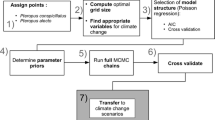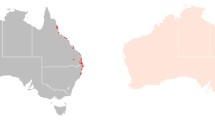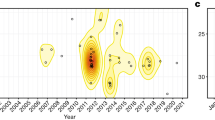Abstract
Understanding environmental factors driving spatiotemporal patterns of disease can improve risk mitigation strategies. Hendra virus (HeV), discovered in Australia in 1994, spills over from bats (Pteropus sp.) to horses and thence to humans. Below latitude − 22°, almost all spillover events to horses occur during winter, and above this latitude spillover is aseasonal. We generated a statistical model of environmental drivers of HeV spillover per month. The model reproduced the spatiotemporal pattern of spillover risk between 1994 and 2015. The model was generated with an ensemble of methods for presence–absence data (boosted regression trees, random forests and logistic regression). Presences were the locations of horse cases, and absences per spatial unit (2.7 × 2.7 km pixels without spillover) were sampled with the horse census of Queensland and New South Wales. The most influential factors indicate that spillover is associated with both cold-dry and wet conditions. Bimodal responses to several variables suggest spillover involves two systems: one above and one below a latitudinal area close to − 22°. Northern spillovers are associated with cold-dry and wet conditions, and southern with cold-dry conditions. Biologically, these patterns could be driven by immune or behavioural changes in response to food shortage in bats and horse husbandry. Future research should look for differences in these traits between seasons in the two latitudinal regions. Based on the predicted risk patterns by latitude, we recommend enhanced preventive management for horses from March to November below latitude 22° south.





Similar content being viewed by others
References
Altizer S, Dobson A, Hosseini P, Hudson P, Pascual M, Rohani P (2006) Seasonality and the dynamics of infectious diseases. Ecol Lett 9:467–84. https://doi.org/10.1111/j.1461-0248.2005.00879.x
Bacaër N, Guernaoui S (2006) The epidemic threshold of vector-borne diseases with seasonality: The case of cutaneous leishmaniasis in Chichaoua, Morocco. J Math Biol 53:421–436. https://doi.org/10.1007/s00285-006-0015-0
Barbet-Massin M, Jiguet F, Albert CH, Thuiller W (2012) Selecting pseudo-absences for species distribution models: how, where and how many? Methods Ecol Evol. https://doi.org/10.1111/j.2041-210x.2011.00172.x
Breiman L (2001) Random forests. Mach Learn 45:5–32.
Cuong HQ, Vu NT, Cazelles B, Boni MF, Thai KTD, Rabaa MA, Quang LC, Simmons CP, Huu TN, Anders KL (2013) Spatiotemporal dynamics of dengue epidemics, Southern Vietnam. Emerg Infect Dis 19:945–953. https://doi.org/10.3201/eid1906.121323
Dowell SF (2001) Seasonal variation in host susceptibility and cycles of certain infectious diseases. Emerg Infect Dis 7:369–374. https://doi.org/10.3201/eid0703.010301
Eby P (1991) Seasonal movements of grey-headed flying-foxes, Pteropus poliocephalus (Chiroptera : Pteropodidae), from two maternity camps in northern New South Wales. Wildl Res 18:547. https://doi.org/10.1071/wr9910547
Eby P, Law BS (2008) Ranking the feeding habitats of Grey-headed flying foxes for conservation management.
Edson D, Field H, McMichael L, Vidgen M, Goldspink L, Broos A, Melville D, Kristoffersen J, de Jong C, McLaughlin A, Davis R, Kung N, Jordan D, Kirkland P, Smith C (2015) Routes of Hendra Virus Excretion in Naturally-Infected Flying-Foxes: Implications for Viral Transmission and Spillover Risk. PLoS One 10:e0140670. https://doi.org/10.1371/journal.pone.0140670
Elith J, Leathwick JR, Hastie T (2008) A working guide to boosted regression trees. J Anim Ecol 77:802–13. https://doi.org/10.1111/j.1365-2656.2008.01390.x
Escobar LE, Peterson AT, Favi M, Yung V, Pons DJ, Medina-Vogel G (2013) Ecology and geography of transmission of two bat-borne rabies lineages in Chile. PLoS Negl Trop Dis 7:e2577. https://doi.org/10.1371/journal.pntd.0002577
Estrada-Peña A, Ostfeld RS, Peterson AT, Poulin R, de la Fuente J (2014) Effects of environmental change on zoonotic disease risk: An ecological primer. Trends Parasitol 30:205–214. https://doi.org/10.1016/j.pt.2014.02.003
Farber O, Kadmon R (2003) Assessment of alternative approaches for bioclimatic modeling with special emphasis on the Mahalanobis distance.
Field H, Jordan D, Edson D, Morris S, Melville D, Parry-Jones K, Broos A, Divljan A, McMichael L, Davis R, Kung N, Kirkland P, Smith C (2015) Spatiotemporal Aspects of Hendra Virus Infection in Pteropid Bats (Flying-Foxes) in Eastern Australia. PLoS One 10:e0144055. https://doi.org/10.1371/journal.pone.0144055
Field HE, de Jong C, Melville D, Smith C, Smith I, Broos A, Kung N, McLaughlin A, Zeddeman A (2011) Hendra virus infection dynamics in Australian fruit bats. PLoS One 6:e28678. https://doi.org/10.1371/journal.pone.0028678
Field HE, Smith CS, de Jong CE, Melville D, Broos A, Kung N, Thompson J, Dechmann DKN (2015) Landscape Utilisation, Animal Behaviour and Hendra Virus Risk. Ecohealth 13:26–38. https://doi.org/10.1007/s10393-015-1066-8
Fisman DN (2007) Seasonality of infectious diseases. Annu Rev Public Health 28:127–43. https://doi.org/10.1146/annurev.publhealth.28.021406.144128
Giles JR, Plowright RK, Eby P, Peel AJ, McCallum H (2016) Models of Eucalypt phenology predict bat population flux. Ecol Evol 1–16. https://doi.org/10.1002/ece3.2382
Goldspink LK, Edson DW, Vidgen ME, Bingham J, Field HE, Smith CS (2015) Natural Hendra Virus Infection in Flying-Foxes - Tissue Tropism and Risk Factors. PLoS One 10:e0128835. https://doi.org/10.1371/journal.pone.0128835
Grassly NC, Fraser C (2006) Seasonal infectious disease epidemiology. Proc Biol Sci 273:2541–50. https://doi.org/10.1098/rspb.2006.3604
Haining R (2003) Spatial data Analysis: Theory and Practice. Cambridge University Press, Edinburgh
Halpin K, Field HE (1996) Identification of likely natural hosts for equine Morbillivirus. Commun Dis Intell 20:1996.
Halpin K, Hyatt AD, Fogarty R, Middleton D, Bingham J, Epstein JH, Rahman SA, Hughes T, Smith C, Field HE, Daszak P (2011) Pteropid bats are confirmed as the reservoir hosts of henipaviruses: a comprehensive experimental study of virus transmission. Am J Trop Med Hyg 85:946–51. https://doi.org/10.4269/ajtmh.2011.10-0567
Hijmans RJ (2012) Cross-validation of species distribution models : removing spatial sorting bias and calibration with a null model. Ecology 93:679–688.
Holt RD, Pickering J (1985) Infectious Disease and Species Coexistence : A Model of Lotka-Volterra Form. Am Nat 126:196–211.
Hudson IL, Kim SW, Keatley MR (2010) Climatic Influences on the Flowering Phenology of Four Eucalypts: A GAMLSS Approach. In: Hudson IL, Keatley MR (eds) Phenological Research. Springer, London, pp 209–228
Jiménez-Valverde A, Lobo JM, Hortal J (2008) Not as good as they seem: the importance of concepts in species distribution modelling. Divers Distrib 14:885–890. https://doi.org/10.1111/j.1472-4642.2008.00496.x
Lo Iacono GL, Cunningham AA, Moses LM, Iacono G Lo, Cunningham AA, Fichet-calvet E (2016) A Unified Framework for the Infection Dynamics of Zoonotic Spillover and Spread. PLoS One. https://doi.org/10.1371/journal.pntd.0004957
Marmion M, Parviainen M, Luoto M, Heikkinen RK, Thuiller W (2009) Evaluation of consensus methods in predictive species distribution modelling. Divers Distrib 15:59–69. https://doi.org/10.1111/j.1472-4642.2008.00491.x
Martin G, Plowright R, Chen C, Kault D, Selleck P, Skerratt L (2015) Hendra virus survival does not explain spillover patterns and implicates relatively direct transmission routes from flying foxes to horses. J Gen Virol vir.0.000073. https://doi.org/10.1099/vir.0.000073
Martin G, Webb RJ, Chen C, Plowright RK, Skerratt LF (2017) Microclimates Might Limit Indirect Spillover of the Bat Borne Zoonotic Hendra Virus. Microb Ecol 1–10. https://doi.org/10.1007/s00248-017-0934-x
Martin G, Yanez-Arenas C, Roberts BJ, Chen C, Plowright RK, Webb RJ, Skerratt LF (2016) Climatic suitability influences species specific abundance patterns of Australian flying foxes and risk of Hendra virus spillover. One Heal 2:115–121. https://doi.org/10.1016/j.onehlt.2016.07.004
Martínez-Meyer E, Díaz-Porras D, Peterson AT, Yáñez-Arenas C (2013) Ecological niche structure and rangewide abundance patterns of species. Biol Lett 9:20120637. https://doi.org/10.1098/rsbl.2012.0637
McFarlane R, Becker N, Field H (2011) Investigation of the climatic and environmental context of Hendra virus spillover events 1994-2010. PLoS One 6:e28374. https://doi.org/10.1371/journal.pone.0028374
Mesgaran MB, Cousens RD, Webber BL (2014) Here be dragons: a tool for quantifying novelty due to covariate range and correlation change when projecting species distribution models. Divers Distrib n/a-n/a. https://doi.org/10.1111/ddi.12209
Moloney BJ (2011) Overview of the epidemiology of equine influenza in the Australian outbreak. Aust Vet J 89 Suppl 1:50–6. https://doi.org/10.1111/j.1751-0813.2011.00748.x
Murray K, Rogers R, Selvey LA, Selleck P, Hyatt A, Gould A, Gleeson L, Hooper P, Westbury H (1995a) A Novel Morbillivirus Pneumonia of Horses and its Transmission to Humans. Emerg Infect Dis 1:31–3n oubr.
Murray K, Selleck P, Hooper P, Hyatt A, Gould A, Gleeson L, Westbury H, Hiley L, Selvey L, Rodwell B (1995b) A morbillivirus that caused fatal disease in horses and humans. Science 268:94–7.
Ostfeld RS, Glass GE, Keesing F (2005) Spatial epidemiology: an emerging (or re-emerging) discipline. Trends Ecol Evol 20:328–36. https://doi.org/10.1016/j.tree.2005.03.009
Owens HL, Campbell LP, Dornak LL, Saupe EE, Barve N, Soberón J, Ingenloff K, Lira-Noriega A, Hensz CM, Myers CE, Peterson AT (2013) Constraints on interpretation of ecological niche models by limited environmental ranges on calibration areas. Ecol Modell 263:10–18. https://doi.org/10.1016/j.ecolmodel.2013.04.011
Páez DJ, Giles J, McCallum H, Field H, Jordan D, Peel AJ, Plowright RK (2017) Conditions affecting the timing and magnitude of Hendra virus shedding across pteropodid bat populations in Australia. Epidemiol Infect 1–11. https://doi.org/10.1017/s0950268817002138
Palmer C, Price O, Bach C (2000) Foraging ecology of the black flying fox (Pteropus alecto) in the seasonal tropics of the Northern Territory, Australia. Wildl Res 27:169–178.
Parsons JG, VanDerWal J, Robson SKA, Shilton LA (2010) The Implications of Sympatry in the Spectacled and Grey Headed Flying-Fox, Pteropus conspicillatus and P. poliocephalus (Chiroptera: Pteropodidae). Acta Chiropterologica 12:301–309. https://doi.org/10.3161/150811010x537882
Pascual M, Dobson A (2005) Seasonal patterns of infectious diseases. PLoS Med 2:e5. https://doi.org/10.1371/journal.pmed.0020005
Peel AJ, Eby P, Kessler M, Lunn T, Breed AC, Plowright RK (2017) Letter to the editor: Hendra virus spillover risk in horses: heightened vigilance and precautions being urged this winter.
Peterson AT (2006) Uses and requirements of ecological niche models and related distributional models. Biodivers Informatics 3:59–72.
Peterson AT, Papes M, Soberon J (2008) Rethinking receiver operating characteristic analysis applications in ecological niche modeling. Ecol Modell 213:63–72. https://doi.org/10.1016/j.ecolmodel.2007.11.008
Plowright RK, Eby P, Hudson PJ, Smith I, Westcott D, Bryden W, Middleton DJ, Reid P, McFarlane R, Martin G, Tabor G, Skerratt LF, Anderson D, Cramery G, Quammen D, Jordan D, Freeman P, Lin-Fa W, Epstein JH, Marsh G, Kung N, McCallum H (2015) Ecological dynamics of emerging bat virus spillover.
Plowright RK, Field HE, Smith C, Divljan A, Palmer C, Tabor G, Daszak P, Foley JE (2008) Reproduction and nutritional stress are risk factors for Hendra virus infection in little red flying foxes (Pteropus scapulatus). Proc Biol Sci 275:861–9. https://doi.org/10.1098/rspb.2007.1260
Plowright RK, Foley P, Field HE, Dobson AP, Foley JE, Eby P, Daszak P (2011) Urban habituation, ecological connectivity and epidemic dampening: the emergence of Hendra virus from flying foxes (Pteropus spp.). Proc Biol Sci. https://doi.org/10.1098/rspb.2011.0522
Plowright RK, Parrish CR, McCallum H, Hudson PJ, Ko AI, Graham AL, Lloyd-Smith JO (2017) Pathways to zoonotic spillover. Nat Rev Microbiol 15:502–510. https://doi.org/10.1038/nrmicro.2017.45
Plowright RK, Peel AJ, Streicker DG, Gilbert A, McCallum H, Wood J, Baker ML, Restif O (2016) Transmission or within-host dynamics driving pulses of zoonotic viruses in reservoir-host populations. PLoS Negl Trop Dis 1–21. https://doi.org/10.1371/journal.pntd.0004796
Power AG, Mitchell CE (2004) Pathogen spillover in disease epidemics. Am Nat 164 Suppl:S79-89. https://doi.org/10.1086/424610
R-Development-Team (2014) R: A language and environment for statistical computing.
Raes N, Ter Steege H (2007) A null-model for significance testing of presence-only species distribution models. Ecography (Cop) 30:727–736. https://doi.org/10.1111/j.2007.0906-7590.05041.x
Richards GC (1990) The spectacled flying-fox, Pteropus conspicillatus (Chiroptera: Pteropodidae), in north Queensland. 2. Diet, seed dispersal and feeding ecology. J Aust Mammal 13:25–31.
Scanlan JC, Kung N, Selleck P, Field H (2014) Survival of Hendra Virus in the Environment: Modelling the Effect of Temperature. Ecohealth. https://doi.org/10.1007/s10393-014-0920-4
Smith C, Skelly C, Kung N, Roberts B, Field H (2014) Flying-fox species density - a spatial risk factor for hendra virus infection in horses in eastern australia. PLoS One 9:e99965. https://doi.org/10.1371/journal.pone.0099965
Smith CS, McLaughlin A, Field HE, Edson D, Mayer D, Ossedryver S, Barrett J, Waltisbuhl D (2016) Twenty years of Hendra virus: laboratory submission trends and risk factors for infection in horses. Epidemiol Infect 1–8. https://doi.org/10.1017/s0950268816001400
Soberón J, Peterson AT (2005) Interpretation of Models of Fundamental Ecological Niches and Species Distributional Areas. Biodivers Informatics 2:1–10. https://doi.org/10.1093/wber/lhm022
Sultan B, Labadi K, Guégan J-F, Janicot S (2005) Climate drives the meningitis epidemics onset in west Africa. PLoS Med 2:e6. https://doi.org/10.1371/journal.pmed.0020006
Thuiller W, Araújo, Miguel B, Lavorel S (2003) Generalized models vs. classification tree analysis: predicting spatial distributions of plant species at different scales. J Veg Sci 14:669–680. https://doi.org/10.1111/j.1654-1103.2003.tb02199.x
Vardon MJ, Brocklehurst PS, Woinarski JCZ, Cunningham RB, Donnelly CF, Tidemann CR (2001) Seasonal habitat use by flying-foxes, Pteropus alecto and P. scapulatus (Megachiroptera), in monsoonal Australia. J Zool 253:523–535. https://doi.org/10.1017/s0952836901000486
Veloz SD (2009) Spatially autocorrelated sampling falsely inflates measures of accuracy for presence-only niche models. J Biogeogr 36:2290–2299. https://doi.org/10.1111/j.1365-2699.2009.02174.x
Webb BYLJ (1959) A physiognomic classification of Australian rain forests. J Ecol 47:551–570. https://doi.org/10.2307/2257290
Williamson MM, Hooper PT, Selleck PW, Gleeson LJ, Daniels PW, Westbury HA, Murray PK (1998) Transmission studies of Hendra virus (equine morbilli-virus) in fruit bats, horses and cats. Aust Vet J 76:813–818. https://doi.org/10.1111/j.1751-0813.1998.tb12335.x
Williamson MM, Hooper PT, Selleck PW, Westbury HA, Slocombe RF (2000) Experimental hendra virus infectionin pregnant guinea-pigs and fruit Bats (Pteropus poliocephalus). J Comp Pathol 122:201–7. https://doi.org/10.1053/jcpa.1999.0364
Acknowledgements
The College of Public Health, Medical and Veterinary Sciences, James Cook University, was contracted by the Rural Industries Research and Development Corporation to undertake this research project. This research was funded by the Commonwealth of Australia, the State of New South Wales and the State of Queensland under the National Hendra Virus Research Program. HeV incident locations are by courtesy of the State of Queensland, through the Department of Agriculture, Fisheries and Forestry, Biosecurity Queensland, thanks to Dr. Craig Smith. We would also like to thank Dr David Páez and the reviewers for their valuable comments on the manuscript.
Author information
Authors and Affiliations
Corresponding author
Electronic supplementary material
Below is the link to the electronic supplementary material.
Rights and permissions
About this article
Cite this article
Martin, G., Yanez-Arenas, C., Plowright, R.K. et al. Hendra Virus Spillover is a Bimodal System Driven by Climatic Factors. EcoHealth 15, 526–542 (2018). https://doi.org/10.1007/s10393-017-1309-y
Received:
Revised:
Accepted:
Published:
Issue Date:
DOI: https://doi.org/10.1007/s10393-017-1309-y




